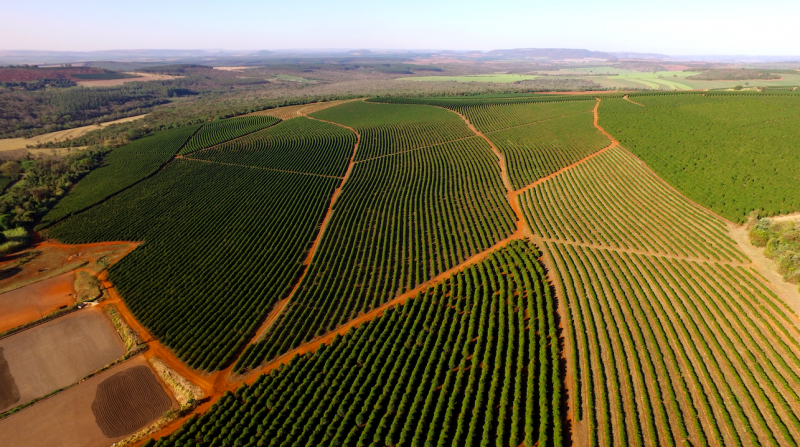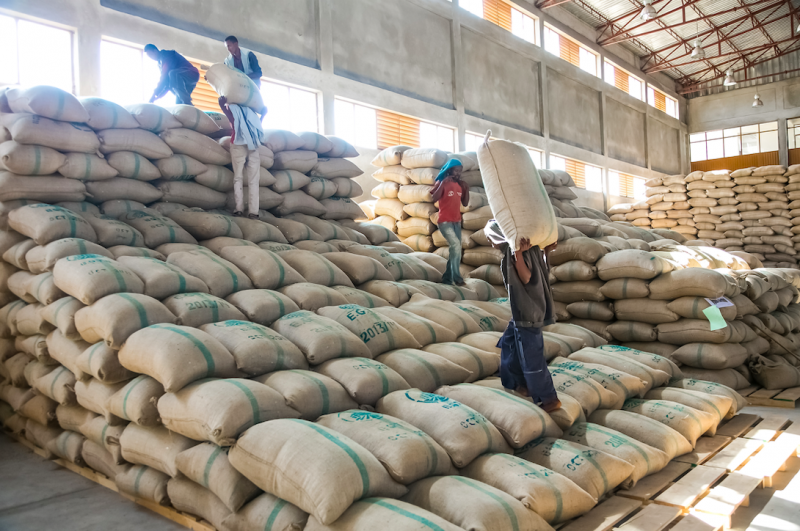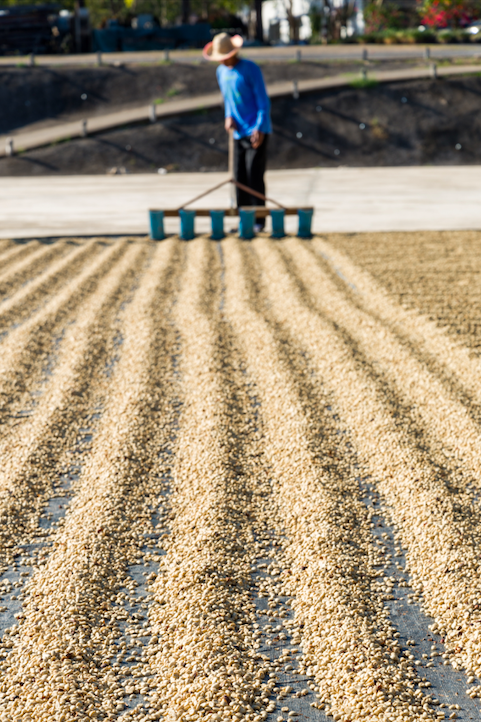THE RISE AND RISE OF GREEN COFFEE
Coffee has gone up and it’s unlikely to fall in the foreseeable future, we asked expert coffee consultant Charles Denison for some insight into just what is going on with our favourite beverage.
First Published in Issue 39 of The Coffee Magazine

Words by Charles Denison
In case you missed the big news at the end of 2021, arabica coffee futures (the green coffee price) rose by 76% in 2021, making it the largest price rise of any major commodity! The current high prices are a complex result of weather (frosts and droughts in Brazil and droughts in Vietnam), supply-chains global shipping crisis, and a spike in demand (mostly due to large importers over-purchasing in order to guarantee supply). To put this into perspective for the South African coffee community, it’s important to look at what this means for local roasters, consumers, retailers, and of course what it means for the coffee farmers at origin.
The increase in the coffee price this past year is the largest in more than a decade, but even more impactful is the actual rand price once the exchange rate has been taken into consideration. While the market price rose significantly, the rand weakened against the dollar as well, giving us a relative increase of over 120%. As an example, in rand terms per kilogram:
1998-2008
Avg. price R14,57/kg
High price R 27,99/kg
2009-2020
Avg. price R32,22/kg
High price R54,25/kg
2021
Avg. price R51,14/kg
High price R89.24/kg
2022
Current price averaging around R80/kg (Feb/March 2022)
*It’s important to remember these are prices from the coffee exchange, not actual prices South African roasters pay for their green coffee.
The most direct relation to these price increases are the standardised Brazil Santos NY2/3 which is widely used in South African blends. In January 2021, the average price between two of the country’s largest importers was R51/kg, while in January 2022, the price was R79/kg. However, that is if one can even get stock of this popular coffee due to the shipping crisis (the author estimates a calculated current stock holding in South Africa at below 20% on five year average).
Specialty coffee prices, while further removed from the market price, are showing significant increases as well. An interesting consideration as well is the quality of standard commercial grade coffee on offer – ten years ago, the demand and price for specialty coffee was not yet at the point where it made sense to separate all quality grades from mixed commercial lots. This led to many standardised blended lots (such as a Tanzania AB FAQ) having a percentage of specialty mixed in. However, with the pricing and demand for specialty growing, this is no longer the case, and these coffees are being separated out, leaving our commercial coffee worse off than it may have been in the past.
HOW THE MARKET WORKS
Although there are over 124 known species of the Coffea plant, only two are commercially grown worldwide on a scale worth considering: Arabica (Coffea arabica) and Robusta (Coffee canephora). Arabica is used to make the world’s finest-tasting coffees, often sold as single-origin or estate products, or in high-quality premium blends. It accounts for between 55-60% of the worlds production. Robusta is grown at lower altitudes and is hardier, typically yielding lower quality, much of which is used to produce soluble coffee (instant coffee). Brazil, at the last count, produced over 55% of the worlds coffee beans – giving Brazil a proportionality large role in influencing the world coffee price. Colombia, on the other hand, is the largest producer of washed arabica. Arabica coffee is the world benchmark for coffee futures contracts that trade on the Inter-Continental Exchange (ICE), and what I will be referring to in this article.
In South Africa particularly, green bean importers purchase coffee in a complex system based on three main variables that affect landed price (with container shipping rates a further variable being up over 400% year-on-year in some cases, with significant increases in transit times affecting cashflow):
1. The coffee futures markets in New York (arabica) and London (robusta) project the future prices for standardised coffee qualities. This is a classic method for pricing commodities. The prices reflect the estimated availability and demand of coffee. The futures prices that serve as benchmarks for the coffee industry are openly negotiated in the markets of the coffee futures exchanges. The coffee futures market is an excellent example of the basic economic theory explaining that price is based on the relationship between supply and demand. However, the situation is more complex. There is no single coffee price, because coffee is a complex natural product full of variation and differentiation. The New York Coffee price is traded in United States Dollars (US$), represented as cents per pound.
2. The rand/dollar exchange rate comes into play due to the coffee price being traded in dollars and imported to South Africa. There is an historic trend where – all other variables being equal – when the dollar is stronger, commodities are weaker, and visa-versa (due to most producing countries gaining forex for the sale of commodities exported). This generally helps to hedge the local market against large fluctuations. However, when the rand is technically weak based on other variables, as is currently the situation in South Africa, and the coffee price is high, the situation is exasperated.
3. Coffee is fairly unique in the world of commodity trading due to the large numbers of qualities, bean sizes, cup profiles, and other variables influencing price. This is the reason for the pricing mechanism of differentials being added or subtracted from the market price – a mechanism that doesn’t have any regulation. Customer and supplier first agree on a price differential – a price difference between the futures market price and the price for specific coffee quality. The differential considers the physical availability of a particular quality, terms and conditions on which it is offered for sale, currency conversion rates to US dollars, etc. Differentials can be extremely volatile, and no mechanisms are in place to offset the differential risk. Once the price is fixed, the differential is added (or subtracted) to the futures coffee price of that specific moment in time for a final price. An example of these differentials and their variation can be seen in the current average differential for a Kenya AA FAQ at +150usc/lb, Tanzania AA FAQ at +60usc/lb, and Uganda Bugisu AA at +5usc/lb, that is over and above the market price.
DO THE FARMERS BENEFIT FROM THIS INCREASE?
This is a hard questions to answer. Yes they do, but probably not as much as one would expect. The system of benefits trickling down to the farmer is not as linear as the percentage increase in prices. This is affected by fixed costs, middle-men, local currency exchanges, increasing inputs (especially fertiliser), and of course varying differentials by region and quality. The market price is only one aspect of the farmers price, just as the crude oil price changes are not directly linear to the fuel pump prices.
But the problem is bigger than this, and comes down to the negotiating power of the farmers (or lack thereof with non-organised smallholders). There are over 12.5 million coffee farms worldwide, with about 95% of these being smaller than five hectares and considered ‘smallholder’. Almost half of these farms can be found in Ethiopia (2.2 million), Uganda (1.8 million) and Indonesia (1.3 million). Viet Nam, Burundi, Kenya and Colombia each have more than 500,000 farmers. Small producers are the backbone of this giant global industry and at least 5.5 million live below the international poverty line of $3.20 a day. The highest levels of poverty are observed in Africa and Oceania.
Furthermore, the trading and futures tools generally remain unreachable to the largest group of actors: smallholder coffee producers, who often lack adequate economic resources and specific financial education. Access to these tools is also extremely complicated for non-organised farmers. The generally disaggregated nature of smallholder coffee producers globally means they must accept the role of “price-takers” of these globally leveraged financial mechanisms, because they often lack the resources to participate directly.

Large scale Brazilian coffee plantation. ©Paulo Vilela
WHAT CAN WE EXPECT IN THE NEAR FUTURE
The forecasting and predictability of the coffee market has become significantly more difficult since the abolishment of quotas in production and consumption, with weather incidences playing a large role in further unpredictability. As mentioned above, the market price is not directly correlated to the end-consumer price, however we have yet to feel the knock-on effect of the market increases at retail and cup level. Throughout the world, and especially in South Africa with the relative weakness of the rand to the dollar, the next six months will see significant increases along the value chain, most significantly in cafés and restaurants, as well as coffee on the supermarket shelves.
CNBC and Rabobank analysts expect tightness in the market to continue all the way into 2023, with further adverse weather conditions expected. Together with the shipping crisis, this shows a coffee market in chaos. The coffee market as a whole swung from a surplus to a deficit this year of 5.2 million bags. The first estimate for Brazil’s coffee harvest in 2022 shows that the yield should increase by 16.8 percent from last year to 55.7 million sacks of 60kg as the country enters the "on-year" in arabica's biennial production cycle. In 2021, the total amount of coffee produced was 47.7 million sacks. The prediction, however, is below 2020’s yield of 63 million 60kg sacks.
The world is sitting on large stocks of coffee due to their simply not being enough ships running to transport it, there is no significant shortage of beans predicted for 2022, especially with Brazil’s increases. However, logistics is going to prove challenging in getting the coffee to the roasters around the world, and the concern has to lie with South Africa’s warehouse stock holdings. A shortage of physical coffee in the country could lead to even further increases due to the demand for this limited supply, with larger or more cash-flush roasters stocking up.

Ethiopian warehousing operation. ©Michael Turner
WHAT I RECOMMEND TO ROASTERS
Ensure green stock security and keep open channels with your importers on the latest holdings and their current logistical situation. Blend flexibility is going to be key going forward, with the number of origins available being extremely limited. This is where communicating with your customers ensuring that they understand the crisis we are in, and are empathetic, whether it be wholesale or retail customers, with regard to both prices and blend changes. And most importantly, cup your green samples before buying, as, in order to limit price increases, some importers may sacrifice cup quality or bean size. With all the above mentioned industry troubles, I don’t see the price returning to the 100-150usc/lb in the near or distant future, and would advise getting used to higher prices.
WHAT WE RECOMMEND TO CONSUMERS
Coffee prices have increased, are increasing and will continue to increase – while this may be unsettling, it is important that you as a coffee consumer, and as part of the coffee culture are aware of the reasons why – and try to support your local coffee roastery, baristas and small businesses that rely on coffee, during this time. Try to be open minded about the blend you’re drinking – it may taste slightly different to what you’ve been used to – this is due to what green coffee is available, but rest assured your roaster is just as skilled and probably more determined than ever to give you a great blend - even if the origins change slightly. Try and see it as a new flavour experience! Try to buy a few bags of different single origins instead of your go-to house blend. Give your roaster feedback and share the flavour notes or your taste experience with other regulars - you might find something new and exciting that you’ve never tasted before.

Coffee parchment drying in Vietnam ©Tassaphon Vongkittipong